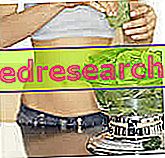What is the South Beach Diet?
The south beach diet is a dietary plan devised by cardiologist Arthur Agatston, who describes it extensively in his book entitled " The South Beach Diet: The Delicious, Doctor-Designed, Foolproof Plan for Fast and Healthy Weight Loss ".

How to follow the Diet
Phase 1
Like the Atkins diet, the "south beach diet" also includes a first induction phase in which the consumption of carbohydrates is reduced to a minimum (only vegetables with a very low glycemic index are tolerated). This is the hardest period of the whole diet but, according to Dr. Agatston, induces those metabolic adaptations necessary to favor the body's consumption of fat.
At least in this first phase we must say goodbye to bread, pasta, rice, potatoes, fruit, spirits, cakes, ice cream and sugar. The first foods on the list will then be gradually reintroduced into the second and third phases.
The south beach diet expects the induction period to last a couple of weeks, promising an initial weight loss of 4-6 kg.
Example of a diet menu:
BREAKFAST
- Scrambled eggs with 2 slices of bacon, centrifuged with vegetables
- Tea or decaffeinated coffee corrected with skimmed milk and / or artificial sweeteners
- MID MORNING SNACK
- Celery stuffed with low-fat cheese
LUNCH
- Salad with green leafy vegetables, turkey, ham and low-fat cheese
- AFTERNOON SNACK
- 10 cherry tomatoes with lean ricotta
DINNER
- Tuna, peas and cabbage with olive oil
- DESSERT AFTER DINNER
- Thin ricotta with almonds
All meals, including snacks and evening desserts, must be consumed obligatorily, even if you do not feel the desire to eat. It is also important to take an adequate amount of water every day.
Phase II
The second phase is similar to the first but is more tolerant of polysaccharides.
The south beach diet in fact provides for the gradual reintroduction of foods rich in fiber and complex carbohydrates such as pasta, rice and whole grains. The consumption of these foods must however remain at a moderate level, far lower than that envisaged by the Mediterranean diet. Even the skimmed milk, most of the fruit, legumes and red wine can be included in the diet with relative tranquility.
Bananas, carrots, foods rich in refined carbohydrates, potatoes, pineapples and honey should instead be consumed extremely sparingly.
The south beach diet requires this second phase to be followed until the ideal weight is reached. It is not possible to quantify this time frame, since it depends on the starting weight, the way in which a person follows the diet and how his body responds to the new food plan.
Phase III
The third phase is characterized by an even more liberal dietary approach that must be maintained throughout life (three portions of cereal and three fruit can be freely consumed every day). The sacrifices made in the first two phases and the understanding of the basic principles of the south beach diet, should guarantee, at least in theory, the maintenance of a healthy weight.
The transition from the typical dietary habits of Western countries to those recommended by the South Beach diet would also improve the blood lipid profile, preventing overweight, diabetes, cardiovascular diseases in general and some types of cancer.
If, during particular periods of life, the needle of the scale should go up again, it will be sufficient to repeat the entire dietary plan starting from phase I.
Benefits and Defects
merits
- The south beach diet makes a clear distinction between "bad" and "good" carbohydrates, encouraging their consumption. The first category includes sugar and all foods that contain it in significant quantities (sweets, cakes, desserts, baked goods and sugary fruits).
- Good carbohydrates are complex ones associated with fiber, such as those contained in whole grains, vegetables and most of the fruit.
- This strategy has proved to be particularly effective in combating obesity and diabetes.
- The satient power of the proposed foods is generally high and, together with the numerous snacks, avoids the appearance of uncontrolled and dangerous hunger attacks.
- The south beach diet suggests to consume mainly mono and polyunsaturated fats (in particular omega-3) avoiding saturated fats and dangerous trans, better known as hydrogenated fats. Thanks to these particular precautions, the cardiovascular risk decreases considerably and important benefits can also be appreciated in the reduction of body weight.
- The south beach diet often emphasizes the importance of a good breakfast which, along with small and healthy snacks, reduces the risk of arriving hungry for lunch and dinner. This strategy can also be useful to counteract the fall in basal metabolism linked to the strong caloric restriction that characterizes the induction phase.
Defects
- Phase I of the south beach diet is too restrictive and poor in vitamins, carbohydrates and mineral salts. For the umpteenth time it must be emphasized that losing weight is not synonymous with losing weight. The kilos lost in the first period are in fact due in large part to muscle catabolism, consumption of carbohydrate reserves and consequent dehydration.
- Not enough space is reserved for physical exercise which, in any self-respecting food program, must be understood as an integral part of the diet.
- The south beach diet is not based on the calculation of calories which, although not the only important element of a diet, must still be taken into consideration.
- Such an approach risks nullifying the slimming effects of the diet, especially when it is followed by a person who does not know, at least in general terms, the caloric intake of the various foods.



